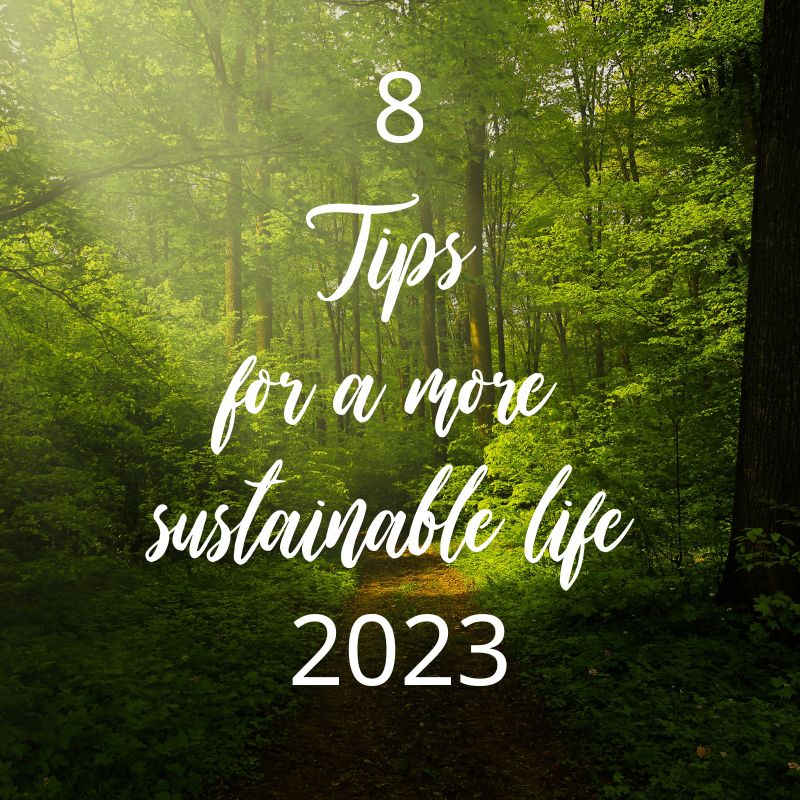8 Tips for a More Sustainable Life-in-2023

Looking at the effects that the climate crisis is having and will continue to have on our lives; a more sustainable lifestyle should be on everyone’s agenda this year.
You don’t have to make huge changes all of a sudden, but you can create new habits that in turn will transform the way you live your life. Let’s look at a few things that might help you to lower your environmental impact and live a more sustainable life.
What is a Sustainable Life?
Everyone is talking about it: Sustainability, zero waste, low-impact, eco-friendly. But what exactly is the goal of a sustainable lifestyle?
Living sustainably simply means considering our planet when making lifestyle choices. The main goal of a sustainable way of life is to reduce the overall impact your life has on the environment and to not use more resources than the planet can naturally replenish. There are many different ways to achieve this, as basically everything you do always has an impact. From the food you are eating and the way you get to work, to how often you buy new clothes or the toothpaste you are using.
It might seem that changing your toothpaste or your shopping habits will not make a difference. However, small changes are all it takes! Once you start becoming more aware of your choices and consumption, you will find that you are automatically making better choices for yourself and the environment. And even better, you will also inspire your family and friends to look at their choices, which in turn will inspire their family and so forth. And all those changes will add up, after all: “Individually, we are one drop – Together, we are an ocean.” (Quote: Ryunosuke Satoro).
8 Ways to Live a More Sustainable Life
1. Use What You Have
The most sustainable thing is the thing you already have. And this is true even if it’s made out of plastic or similar problematic materials. What matters is that it has already been made. Energy and resources have been used to create this product, so by using it, you prevent more energy being used to create a replacement product – even if the replacement product is produced sustainably.
Use what you have and only replace it with eco-friendly alternatives once products are broken or unusable.
2. Conscious Purchases
According to the 2015/16 Household Budget Survey conducted by the CSO, an average Irish household spends €845 every week. Every Euro spent of this weekly budget has the power to positively impact climate change. Buying from ethical and sustainable producers and retailers as well as choosing to buy plastic-free products in supermarkets will eventually create a shift in demand. Whenever consumers demand – the market will change accordingly.
Another aspect of buying consciously is not to buy for the sake of buying. Only buy what you really need. This is often easier said than done. Clever marketing and capitalism lead you into thinking that you need way more than you actually do. Try and avoid impulse buys, instead think about purchases for a day or two. More often than not you will find that you don’t need much to live a fulfilled and still modern life.
3. Replace Consumable Products
Instead of replacing non-sustainable products which you could still use for many years, like plastic lunchboxes for example; look at consumable products. When you replace liquid shampoo in a plastic bottle with a shampoo bar the impact will be much higher. In the long run, you will save many plastic bottles from going to landfill.
Other swap suggestions of consumable products that will make a difference are:
Toothbrushes, Dental Floss, Bath Loofahs, Soaps, Deodorants, Feminine Care, Toilet Roll, and Kitchen Roll
4. Reduce Waste & Single-use Plastic
This might be an obvious one and you might already be very aware of the waste you create. However, there is nothing wrong with trying to strive towards the ultimate goal of a zero waste lifestyle – after all, every little helps!
No matter if you are already trying to lower the weight of your rubbish and recycling bin or if you are just starting to look at ways to create less waste. Replacing any single-use plastic you consume is always a good idea. This doesn’t just include the obvious offenders like clingfilm or plastic bags, but also wrapping, cotton buds, balloons, and take-away containers.
Some single-use items that can easily be replaced with reusable or sustainable products:
Plastic bag – replace with cotton produce bags
Disposable coffee cup – replace with a reusable coffee cup
Plastic bottle – replace with a reusable water bottle
Clingfilm – replace with beeswax wraps
Disposable takeaway food containers – replace with reusable lunchboxes
Plastic straw – replace with reusable straws
Repairing broken items is another way of reducing your household waste. Glue broken toys, mend little holes in clothes, have appliances fixed instead of replaced and so on. This will not just reduce the amount of waste you send to landfill but will also save you money.
One more waste contributor, which often gets overlooked is food waste. Food costs energy and resources when grown and produced. Hence wasting food equals wasting resources. According to the government, every Irish household creates approximately 117 kilograms of food waste every year. Most of the domestic food waste is incorrectly sent to landfill, where it breaks down naturally creating unnecessary methane gas, which is harmful to the environment. While meal planning and buying just what you need will help you to reduce the amount of food waste you create, a brown bin ensures thrown out food and organic waste will end up in appropriate composting facilities.
Did you know - if you live in a town with a population of 500 people or more your bin provider is obliged to supply you with a brown bin?
5. Participate in Freecycling, Swap Shops or Second-hand Markets
When the most sustainable thing is what you already have, the next best thing is what someone else already has and doesn’t need anymore.
Buying second-hand or product swapping contributes to a circular economy by keeping things out of landfill and instead allowing them to be used over and over again. However, buying pre-loved or passing things on doesn’t just reduce the overall mountain of landfill or recycling waste, but also saves energy and resources that would need to be spent producing a new item. And it also saves you some cash!
6. Grow Your Own & Foraging
If your circumstances allow it, growing your own vegetables and fruit is a great way to reduce your carbon footprint. Produce grown in your backgarden doesn’t have to travel around the world to be bought by you. Even if you don’t have space for a vegetable patch, buying locally grown and seasonal food will achieve similar results. Many plants and especially herbs can also be grown in pots on your window sills or in your sunroom. A nice side-effect of growing your own is that you can save money and can be absolutely sure that no pesticides have been used.
Not having any luck with gardening? Try and use what is already growing in the wild forests and fields. Foraging has become more and more popular over the last few years. By investing some time collecting blackberries, elderflower or elderberry you can make jam, cordial and an immune-boosting tonic to last throughout winter and beyond.
7. Make Sustainable Transportation Choices
We know that flying is one of the worst offenders when it comes to carbon emissions. Not taking any flights is easier said than done, especially when living on an island. Like with everything else though it is a good start to make conscious decisions about your transportation. Maybe taking the ferry for your family holiday could be part of the fun and perhaps a conference call or two could replace a few business trips.
Choosing to leave your car at home and walk, bike or take the bus and train instead can also make a difference to your daily impact on the environment. Even just planning your journeys in a way that you have one big journey to run all your errands instead of many small ones can have a positive effect and reduce your carbon footprint.
8. Use Your Voice
Just as important and effective as it is to keep working on your own carbon footprint by looking at your lifestyle and making small changes and improvements to shape a more sustainable future; it is also vital to use your voice!
Share your experiences and everything you learn about the environment and about climate change with your family, friends, colleagues, and neighbours. Even talk to strangers on the bus or in your doctor’s waiting room. The conversation needs to be started and continued far and wide. Every time you talk about your efforts it will plant a seed in other people’s minds – even when you are met with ignorance or when you are belittled. Every little chat has the potential to change one small thing in another person’s lifestyle and if that person shares it with someone else and that someone else passes on the information and so on – THEN your little chat has the potential to ACTUALLY save the world!
What do YOU think - have you any tips to share? Is a more sustainable life on your list for 2023?
